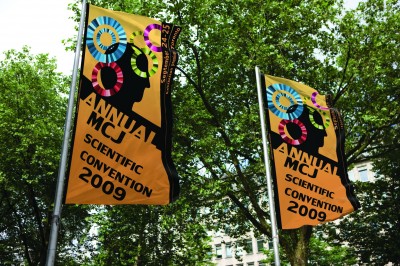Trends in fabric graphics
by Matthew | 18 February 2012 3:57 pm
 [1]
[1]Photos courtesy HP Canada
By Kevin McKay
New printing technologies continue to meet the needs of an increasingly ‘visual’ world. Using fabrics rather than traditional papers or polyvinyl chloride (PVC), for example, soft signage is now a rapidly growing segment of the wide-format digital printing market.
There are a number of reasons for this growth. With their distinctively upscale look and feel, fabrics can support higher-margin applications, including interior décor. Their low weight and flexibility offer logistical convenience, as transportation, storage and installation are all easier and more cost-effective than with other substrates. Fabric-based signs can also be uninstalled and reused with less risk of damage.
Another advantage in today’s market is low environmental impact. Many fabrics today are made of sustainable and/or recycled materials—and some can be recycled after use.
Fabrics can be very versatile. Depending on the specific type chosen for printing, different effects are possible. Options include polyesters, poly-blends, natural fibres, natural blends and a range of synthetics. Special materials like voile, for example, which is thin and semi-transparent, can be used to define and separate indoor spaces.
While polyester-based fabrics typically cost more than PVC for banners, the resulting soft signage can sell for as much as four times the price, leaving the sign shop with a significant profit margin.
 [2]
[2]Fabrics can achieve a variety of effects, including semi-transparency. Photo by Peter Saunders
Print productivity
The material itself, however, is only half the story. Durable aqueous inkjet printing, such as with ‘latex’ water-based inks, is also helping signage applications—both indoors and outdoors—take advantage of fabric graphics, including point-of-purchase (POP) displays, exhibition graphics, wall murals and event banners.
Latex inks, by way of example, are a hybrid of pigmented water-based inks combined with aqueous-dispersed polymers. They do not require an external dryer for curing. Both outdoor-durable and odourless for indoor use, they can be printed on a wide variety of coated and uncoated materials, including polyester-based fabrics.
Some of the environmental benefits of water-based inks are also health benefits. Odourless graphics are becoming more important to sign shops’ clients who manage quick-service restaurants (QSRs), medical clinics, fitness centres and other facilities where print-related odours would be a concern. In fact, some of these customers now refuse to buy any graphics that use solvent-based inks.
Odourless inks are an advantage for sign shops, too. Compared to traditional solvent inkjet systems, durable aqueous inkjet printers do not require the purchase, installation and operation of special ventilation, air monitoring and respiratory protection systems. The printers’ operators do not require any special training for the transportation and use of hazardous materials.
 [3]
[3]Polyester-based fabrics for banners may cost more than PVC, but the resulting soft signage can also sell for a greater price.
High-speed printing with latex inks is increasing productivity for fabric graphics, allowing large volumes of soft signage to be output in little time. This is leading to greater cost efficiencies in the textile printing industry, especially with regard to variable costs like labour.
That said, today’s market often requires low volumes of more personalized output, which are a better match for the durable aqueous inkjet printing niche than for traditional methods like gravure or screenprinting.
Ease of adoption
Fabric printing capabilities can give sign companies an advantage over their competitors, offering a new way to generate revenue with higher profit margins. While these capabilities may seem daunting at first, they have become simpler to implement. The ease of transporting and storing textiles, for example, is not just an advantage for a sign shop’s commercial clients, but also for the shop itself.
As mentioned, digital printing of fabrics is helping sign shops and printing companies target the interior design and home décor markets, as textiles already play an important role in these industries.
Print service providers (PSPs) also see textile printing catching the imagination of designers and yielding new creative applications. This is particularly true as wide-format inkjet printing technology becomes easier and more affordable to adopt, rather than limiting access to those who have invested in a device designed specifically to handle textiles. Digital inkjet printing makes short runs and even one-offs economical, allowing designers to stretch the boundaries of applications—with new image types, textures and effects—that would have been difficult and expensive with past methods. [4]
[4]
In the future, fabric printing technologies will continue to help sign shops generate revenue from new sources, particularly by enabling the production of graphic applications that were previously not available to them, including even mainstream products like upholstery, curtains, lamp shades and garments. High-quality output will earn greater profit margins.
Greener games
One of the primary trends driving the popularity of soft signage in recent years has been a transition away from PVC and other traditional substrates in favour of textiles for environmental reasons.
In 2009, for example, the organizers of the Special Olympics World Winter Games in Boise, Idaho, led an effort to ‘green the games.’ This mission extended to the production and installation of an estimated 4,645 m2 (50,000 sf) of soft signage. These duties were handled by Fusion Imaging and Splash Events, both clients of the games’ corporate sponsor, HP.
The companies used recyclable, flexible media instead of typical PVC banner materials. Splash used a heavy textile banner material, for example, that was recyclable through HP’s free large-format media take-back program. In this way, at the end of use, unwanted graphics—including posters, banners and signs—could be returned via the print service provider (PSP) to the materials’ manufacturer for recycling.
Kevin McKay is national marketing manager for HP Canada’s graphic solutions business. For more information, visit www.hp.ca[5].
- [Image]: http://www.signmedia.ca/wp-content/uploads/2014/02/IMG_5153.jpg
- [Image]: http://www.signmedia.ca/wp-content/uploads/2014/02/49P9800.jpg
- [Image]: http://www.signmedia.ca/wp-content/uploads/2014/02/G11328015112009_JPGHighres.jpg
- [Image]: http://www.signmedia.ca/wp-content/uploads/2014/02/BoDo-Windows-1.jpg
- www.hp.ca: http://www.hp.ca
Source URL: https://www.signmedia.ca/trends-in-fabric-graphics/